A History of the World in 100 Objects

A History of the World in 100 Objects was a multi-month cultural history radio project by the British broadcaster BBC Radio 4 and the British Museum , beginning in January 2010. The 100-part series of radio broadcasts was written and presented by Neil MacGregor , director at the time of the British Museum. In the 15-minute lectures broadcast every working day, MacGregor used 100 selected objects from the British Museum - from art and cultural history such as technology and everyday history - to introduce lines of development, similarities and differences in the history of mankind . The British Museum was for this ambitious project of 100,000 £ doped Prize 2011 Art Fund awarded.
In 2010, MacGregor published the content of the program in a revised form under the same title as a book. The German translation was published in 2011 under the title A History of the World in 100 Objects ; this publication was awarded the 2012 knowledge book of the year (“most original book”).
Subsequently, the British Museum put together a traveling exhibition , also under the same title, partly with other objects, which was sent around the world with great success from 2014 onwards. Stations were until 2017:
- United Arab Emirates , Abu Dhabi , Manarat Al Saadiyat (April 23 to August 1, 2014)
- Taiwan , Taipei , National Palace Museum (December 13, 2014 to March 15, 2015)
- Japan , Tokyo , Art Museum of Tokyo (18 April-28 June 2015); Dazaifu , Kyushu National Museum (July 14 to September 6, 2015); Kobe , Kobe City Museum (September 20, 2015 to January 11, 2016)
- Australia , Perth , Western Australian Museum (February 13 to June 18, 2016); Canberra , National Museum of Australia (September 8, 2016 to January 29, 2017)
- China , Beijing , National Museum of China (March 1 to May 31, 2017); Shanghai , Shanghai Museum (June 28 to October 8, 2017)
List of objects
The following list includes all 100 objects from the British Museum (BM) that were featured on the BBC radio show A History of the World in 100 Objects and Neil MacGregor 's book of the same name based on it , in the order in which they are presented. The radio series ran with interruptions in 2010 for 20 weeks with five episodes on weekdays, accordingly the objects are thematically arranged in groups of five.
The section headings of the list follow the chapter headings of the German-language book edition, the same applies to the names of the individual objects. In the names of the objects, the scientific description is linked to the inventory number of the British Museum. The description there is followed by the time and the information on the place of discovery or production (modern geographical names). The references in the "Brief Description" column refer to the number of pages in the German-language book edition and link to the relevant information pages of the BBC (there further links to the audio contribution of the respective individual broadcast as well as the complete transcriptions of the audio contributions).
Part I - How We Became Humans (2,000,000–9,000 B.C.)
The first five episodes of the radio show started broadcasting January 18, 2010.
| image | No. | object | Place of discovery or production |
time | Brief description |
|---|---|---|---|---|---|
 |
1 | Mummy of Hornedjitef (BM .6677 (sarcophagus), BM .6678 (inner coffin), BM .6679 (mummy)) | al-Asasif , Egypt | around 240 BC Chr. | Mummy of the Egyptian priest Hornedjitef , who was buried in a wooden inner coffin and a surrounding sarcophagus made of wood of the mulberry fig .
This object does not match the chronological order of the episodes; MacGregor deliberately selected it as the first object in the series. He hoped that the popularity and mysteriousness of an object of the Egyptian cult of the dead could arouse interest in the presented artifacts from human history . |
 |
2 | Stone cutting tool of the Oldowan culture (BM 1934,1214.1 ) | Olduvai Gorge , Tanzania |
Old Paleolithic ( Early Stone Age , 2–1.8 million years BC) |
The Oldowan culture's basalt tool , known as a chopper , is the oldest human- made object in the collections of the British Museum. |
 |
3 | Hand ax of the Oldowan culture (BM 1934,1214.49 ) | Olduvai Gorge, Tanzania | Old Paleolithic (Early Stone Age, 1.4–1.2 million years BC) |
This hand ax of the Oldowan culture made of volcanic phonolite represents a more advanced tool-making; small hand axes became common tools for cutting meat or for woodworking. |
 |
4th | Swimming reindeer (BM Palart.550 ) | Montastruc rocks, Bruniquel , France | 11000 BC Chr. | The 20 cm long ivory sculpture made from a mammoth tusk is one of the oldest works of art in the British Museum. It represents a level of human intellectual development that does not differ from that of the 21st century. |
 |
5 | Spearhead of the Clovis culture (BM 1962,1206.137 ) | Arizona , North America | 11000 BC Chr. | Such spearheads of the Clovis culture are among the oldest artifacts of human settlement in North America . They were used to hunt big game. |
Part II - After the Ice Age: Food and Sex (9000–3500 BC)
Episodes 6 to 10 of the radio show started broadcasting January 25, 2010.
| image | No. | object | Place of discovery or production |
time | Brief description |
|---|---|---|---|---|---|
 |
6th | Pestle in the shape of a bird (BM Oc1908,0423.1 ) | Oro , Papua New Guinea | 6000-2000 BC Chr. | On the one hand, this pestle is a sign of successful grain cultivation, on the other hand, the artful design suggests a culturally developed society. Papua New Guinea is one of seven independent locations on earth where agriculture developed after the last ice age . |
 |
7th | The lovers of Ain Sakhri (BM 1958,1007.1 ) | Bethlehem , West Bank | around 9000 BC Chr. | The oldest known representation of physical love between a man and a woman. |
 |
8th | Egyptian clay model of cattle (BM 1901,1012.6 ) | El-Amra , Egypt | around 3500 BC Chr. | Grave goods; possibly to ensure the care of the deceased according to ancient Egyptian ideas. Domestication of cattle began in North Africa and the Middle East. |
 |
9 | Mayan statue of the corn god (BM Am1923, Maud.8 ) | Copan , Honduras | 715 | The corn god Hun Nal Yeh was worshiped by the Maya of Central America for thousands of years. His statue is an example of the impact the demands of agriculture had on people's conceptions of gods. |
 |
10 | Jōmon culture pot (BM OA + .20 ) | Japan | around 5000 BC Chr. | The pots of the Jōmon culture are the world's oldest known cookware. Many foods are only edible for humans when they have been cooked; pottery was established in China, Japan, and Korea around 12,000 BC. Invented. |
Part III - The First Cities and States (4000–2000 BC)
Episodes 11 to 15 of the radio show were broadcast from February 1, 2010.
| image | No. | object | Place of discovery or production |
time | Brief description |
|---|---|---|---|---|---|
 |
11 | Sandal plaque from King Den (BM 1922,0728.2 ) | Umm el-Qaab , Egypt | around 2985 BC Chr. | The small plaque was a funerary gift for the Egyptian king Den . It expresses the rule of the king and celebrates Den as the victor over enemies in the east. |
 |
12 | Standard of Ur (BM 1928,1010.3 ) | Tombs of the Kings of Ur , Iraq | around 2500 BC Chr. | The wooden box shows inlays on the long and short sides with depictions of people in war and peace situations. |
| 13 | Seal of the Indus culture (BM 1892,1210.1 ) | Harappa , Pakistan | 2500-2000 BC Chr. | The discovery of seals like this one (found in 1870) led to the discovery of the Indus culture . | |
 |
14th | Jade ax (BM 1901,0206.1 ) | Canterbury , England | 4000-2000 BC Chr. | The ax was made in the northern Italian Alps. It shows no signs of use and was probably a status symbol with ritual or ceremonial meaning. |
 |
15th | Early tablet (BM 1989,0130.4 ) | Iraq | 3100-3000 BC Chr. | One of the oldest written records of the people. The cuneiform tablet records the daily beer rations for workers. |
Part IV - The Beginnings of Science and Literature (2000–700 BC)
Episodes 16 to 20 of the radio show started broadcasting February 8, 2010.
| image | No. | object | Place of discovery or production |
time | Brief description |
|---|---|---|---|---|---|
 |
16 | Flood plaque (BM K.3375 ) | Nineveh , Iraq | 700-600 BC Chr. | The Flood tablet from the Aššurbanipal library (panel 11 of the Gilgamesh epic ) is the most famous single cuneiform tablet due to its content and history of reception . The panel contains the story of Utnapishtim , the forerunner of the biblical Flood story . |
 |
17th | Rhind papyrus on mathematics (BM 1865,0218.2 ) | Thebes , Egypt | around 1550 BC Chr. | The most famous mathematics papyrus from ancient Egypt . More than 80 mathematical problems are dealt with, which give an impression of the developed economic complexity of the Egyptian high culture . |
 |
18th | Minoan bull jumper (BM 1966,0328.1 ) | Rethymno , Crete , Greece | 1600-1450 BC Chr. | The small, 15 cm long bronze statuette is a unique work of art. It also opens up a glimpse into the importance of the bull cult and the key material bronze in the Minoan culture . |
 |
19th | Golden Mold shoulder collar (BM 1836,0902.1 ) | Mold , Wales | 1900–1600 BC Chr. | It is not known who this precious piece of jewelry was designed for, but he or she must have been very wealthy for the British Isles' Bronze Age . Such wealth may have arisen from the close proximity of the site to the Great Orme , the largest prehistoric copper mine in northwestern Europe. |
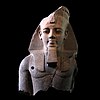 |
20th | Statue of Ramses II (BM .19 ) | Thebes, Egypt | around 1250 BC Chr. | The construction of this monumental statue of one of the most successful Egyptian pharaohs was “the result of an immense and immensely complex technical and logistical process” and demonstrates what the Egyptian economy and society of the time was capable of. At the same time, the statue shows how Ramses perfected his propaganda for success in his long life, which had an impact for thousands of years. |
Part V - Old World, New Powers (1100-300 BC)
Episodes 21 through 25 of the radio show aired from February 15, 2010.
| image | No. | object | Place of discovery or production |
time | Brief description |
|---|---|---|---|---|---|
 |
21st | Lachish relief (BM 1856,0909.14 ) | Nineveh , Iraq | 700-692 BC Chr. | Alabaster relief from the south-west palace of the Assyrian King Sennacherib . It depicts the conquest of the Judean city of Lachish in 701 BC. Chr .; the picture program shows the ruler as a successful military leader and demonstrates the expansion of the Assyrian Empire . |
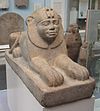 |
22nd | Sphinx of Taharqa (BM 1932,0611.1 ) | Kawa , Sudan | around 680 BC Chr. | A Sphinx with the head of the Kushitic ruler Taharqa , Pharaoh in Egypt 690–664 BC. Chr. |
 |
23 | Chinese ritual vessel from the Zhou period (BM 1977,0404.1 ) | Henan , China | 1100-1000 BC Chr. | The bronze, ritual Chinese cooking vessel ( gui ) with an inscription on the inner bottom commemorates a successful campaign by Kang, the brother of King Wu , against a last uprising of supporters of the Shang dynasty . With this military success, the new rule of the Zhou dynasty in China was finally established. |
 |
24 | Textile of the Paracas culture (BM Am1954,05.563 ) | Paracas , Peru | 1-500 BC Chr. | Textiles were valuables in the Paracas culture , they demonstrated the status and power of the owner. |
 |
25th | Gold coin of Croesus (BM RPK, p146B.1.Sam ) | Turkey | around 550 BC Chr. | One of the earliest coins in human history, minted in Lydia during the reign of the last Lydian king Croesus . The invention of money in Lydia fundamentally and permanently changed world history. |
Part VI - The world in Confucian times (500-300 BC)
Episodes 26 to 30 of the radio show began broadcasting on February 22, 2010.
| image | No. | object | Place of discovery or production |
time | Brief description |
|---|---|---|---|---|---|
 |
26th | Chariot from the Oxus Treasure (BM 1897,1231.7 ) | Takht-i Kuwad , Tajikistan | 500-300 BC Chr. | Golden model of a chariot of the Persian Empire from the Oxus treasure . A driver and a second person, presumably a satrap , sit in the car ; the car demonstrates the efficient management of the large area of the empire. |
 |
27 | Parthenon sculpture: Centaur and Lapith (BM 1816,0610.12 ) | Parthenon , Greece | 447-438 BC Chr. | The sculpture belongs to the Elgin Marbles and exemplifies the humanism of Greek art in the depiction of the suffering person. At the same time, the will of the Greeks to resist the takeover of the Greek city-states into the Persian Empire is demonstrated. |
 |
28 | Jugs from Basse-Yutz (BM 1929,0511.1 ) | Basse-Yutz , France | 450-400 BC Chr. | The two jugs are eye-catching luxury items and outstanding examples of Celtic art . |
 |
29 | Stone mask of the Olmecs (BM Am1938,1021.14 ) | Peten , Guatemala | 900-400 BC Chr. | The open mouth and the childlike face are typical of the mask art of the Olmecs . There are symbols on both sides of the mouth; such Olmec glyphs are the oldest known characters in America. |
 |
30th | Chinese bronze bell (BM 1965,0612.1 ) | Henan , China | 500-400 BC Chr. | Bells of this type are known as Bo . This bell was produced in a time of political crisis in which Confucius also developed his philosophy. He taught the return to traditional values in order to restore social harmony - as it was in the play of bells. |
Part VII - Founders of the Empire (300 BC – 10 AD)
Episodes 31 to 35 of the radio show were broadcast from May 17, 2010.
| image | No. | object | Place of discovery or production |
time | Brief description |
|---|---|---|---|---|---|
 |
31 | Coin with the head of Alexander (BM 1919,0820.1 ) | Lampsakos , Turkey | 305-281 BC Chr. | A coinage commissioned by the Diadochus Lysimachus with the head of Alexander the Great . The coin depicts Alexander as a god - and with the minting of the coin Lysimachus placed himself in his tradition. |
| 32 | Ashoka column (BM 1880.21 ) | Delhi , India | around 250 BC Chr. | Fragment of one of the pillars that Ashoka , a king of the Indian Maurya dynasty , had erected across India. It was on these that the ruler of one of the greatest empires in the history of South Asia spread the Ashoka edicts with his personal philosophy similar to Buddhism . | |
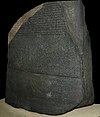 |
33 | Stone of Rosette (BM 1897,1231.7 ) | Egypt | 196 BC Chr. | The Rosetta Stone is one of the most famous and most important objects in the British Museum for classical studies because it reproduces the same text three times in different scripts and languages: a decree confirming the cult of the king for the 13-year-old ruler Ptolemy V. The comparison of contents made it possible to decipher the hieroglyphic writing of the Egyptians for the first time after the stone was found. |
 |
34 | Lacquered Chinese cup from the Han period (BM 1955,1024.1 ) | Sichuan , China | 4th | Such painted objects were very expensive to produce; they were sometimes given to officials as wages or gifts by emperors of the Han Dynasty . An inscription indicates which workers were involved in the production of this mug. |
 |
35 | Head of Augustus (BM 1911,0901.1 ) | Meroe , Sudan | 27-25 BC Chr. | Statues of Augustus were placed throughout the Roman Empire to commemorate the unlimited power of the ruler. |
Part VIII - Ancient Delights, Modern Spices (1–500)
Episodes 36 to 40 of the radio show were broadcast from May 24, 2010.
| image | No. | object | Place of discovery or production |
time | Brief description |
|---|---|---|---|---|---|
 |
36 | Warren Cup (BM 1999,0426.1 ) | Jerusalem , Israel | 5 v. Chr. – 15 AD | Luxurious, elaborately designed silver cup with homoerotic scenes between older and younger men. |
 |
37 | North American otter pipe (BM Am, p.266 ) | Chillicothe , North America | 200 BC Chr. – 400 AD | Together with 200 other tobacco pipes of a similar type decorated with animal sculptures , this object of the Indian Hopewell culture was found during excavations in the burial mounds of the Mound City Group ( Hopewell Culture National Historical Park ), at the beginning of systematic archeology in North America . |
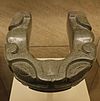 |
38 | Belt for a ritual ball game (BM Am, St. 398 ) | Veracruz , Mexico | 300-1200 | A stone version of a belt like the one used for the Mesoamerican ball games . This version is too difficult to have any function in the game; probably the specimen had a ceremonial meaning. |
 |
39 | Admonition scroll (BM 1903,0408,0.1 ) | Beijing , China | 500-900 | The picture scroll - in text and picture sequence instructions for the appropriate behavior of the court ladies at the Chinese imperial court - is one of the most important works of art in the world. The painter Gu Kaizhi is considered to be the "father of classical Chinese figure painting" (MacGregor 2011). The original was lost early, but this copy, around 200 years younger, is believed to be true to the original. |
 |
40 | Pepper shaker from Hoxne (BM 1994,0408.33 ) | Hoxne , England | 300-400 | The pepper shaker with the sculpture of a Roman woman is part of the Hoxne depot find . Pepper was one of the exotic and expensive spices that linked Europe to India and China via trade routes. |
Part IX - The Rise of World Religions (100-600)
Episodes 41 to 45 of the radio show were broadcast from May 31, 2010.
| image | No. | object | Place of discovery or production |
time | Brief description |
|---|---|---|---|---|---|
 |
41 | Seated Buddha from Gandhara (BM 1895,1026.1 ) | Gandhara , Pakistan | 100-400 | One of the oldest surviving sculptures of a Buddha ; in Buddhism , only symbolic representations were common before the 1st century. This Buddha, who lingers in the lotus position and is dressed as a monk, is depicted in the state of awakening (“ Bodhi ”). |
 |
42 | Gold coins from Kumaragupta I (BM 1894,0506.962 ) | India | 415-447 | This coin from the reign of Kumaragupta (415–455) commemorates the horse sacrifice (" Ashvamedha ") of the kings of the Gupta Empire in northern India. In the course of this dynasty period, such older rituals of the Vedic religion were largely replaced by the less elaborate temple religiosity in the various forms of Hinduism . |
 |
43 | Plate with the portrait of Shapur II (BM 1908,1118.1 ) | Turkey / Iran | 300-400 | The engraving of the silver plate shows the Persian great king Shapur II hunting. Under his rule was the Sassanid Empire of Zoroastrianism promoted by the state as a religion - the same historical period in which the Roman Empire , the Christianity to the imperial church developed. |
 |
44 | Mosaic of Hinton St. Mary (BM 1965,0409.1 ) | Hinton St Mary , England | 300-400 | One of the oldest surviving depictions of Christ from a Roman villa in Dorset , on the periphery of the Roman Empire, from the time when Christianity became the state religion throughout the entire empire. |
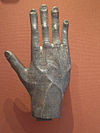 |
45 | Arabic bronze hand (BM 1983,0626.2 ) | Yemen | 100-300 | The bronze hand was an offering to the god Ta'lab in a temple in pre-Islamic Yemen. The right hand has traditionally been a symbol of good luck / success and the inscription on the hand says that it was offered to God in return for well-being. When this hand was made, paganism was already declining due to the popularity of Judaism and Christianity. The Islam has from 622 the pagan past replaced in Arabia in the same way as Christianity everything that remained of the past religions Arabia pagan past in Europe, and items like this are. |
Part X - The Silk Road and Beyond (400-800)
Episodes 46 to 50 of the radio show began broadcasting June 7, 2010.
| image | No. | object | Place of discovery or production |
time | Brief description |
|---|---|---|---|---|---|
| 46 | Gold coins from Abd al-Malik (BM 1874,0706.1 ) | Damascus , Syria | 696-697 | The older coins issued during the reign of the Umayyad caliph Abd al-Malik still show an image of the ruler. One of the two coins shown marks a historic turning point; it is one of the first without a ruler, only with pieces of text from the Koran as an inscription. | |
 |
47 | Sutton Hoo's helmet (BM 1939,1010.93 ) | Sutton Hoo , England | 600-700 | The Sutton Hoo helmet is one of the most important finds in early Anglo-Saxon history in Great Britain. It belonged to a powerful war chief and was placed in the ship's grave when he was buried . The helmet and the other finds from the excavation prove the international trade relations of the Anglo-Saxons. |
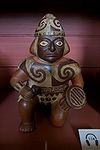 |
48 | Vessel of the Moche in the form of a warrior (BM Am, P.1 ) | Peru | 100-700 | The Moche culture was one of the oldest states in South America. Leftovers like such pottery show that cultures on the American continent developed similarly to those in Europe, Africa and Asia at the same time - even if there was no cultural contact. |
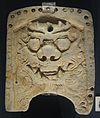 |
49 | Korean roof tile (BM 1992,0615.24 ) | Gyeongju , South Korea | 600-800 | Roof tiles from the old capital of the Korean Silla Empire, Gyeongju , which was supposed to ward off evil spirits. Similar bricks had previously been used in China, but their artistic design flourished again in Korea. |
| 50 | Painting of a silk princess (BM 1907,1111.73 ) | Dandan Oilik , China | 600-800 | The wooden panel painting shows scenes from the legend of the "silk princess" who allegedly betrayed the secret of silk production , which is closely guarded in China . The painting was discovered during excavations in an oasis city on the Silk Road , which for centuries was the vital trade route between the Mediterranean region and the Asian civilizations. |
Part XI - Inside the Palace: Secrets at Court (700–900)
Episodes 51 to 55 of the radio show started broadcasting June 14, 2010.
| image | No. | object | Place of discovery or production |
time | Brief description |
|---|---|---|---|---|---|
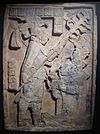 |
51 | Mayan relief of a royal blood ritual (BM Am1923, Maud.4 ) | Yaxchilan , Mexico | 723-726 | Relief from the lintel of a Mayan temple; the ruler's wife pulls a thorn rope through her tongue. The ruler's power was based on the knowledge that he was supposedly able to gain by making contact with the supernatural world through blood rituals. |
 |
52 | Wall paintings from a harem (BM OA + .10622 ) | Samarra , Iraq | 800-900 | Fragments from wall paintings in the harem of the caliph al-Mutasim in Samarra . The caliph re-established the city as the center of the Abbasid Islamic empire ; it became the seat of government in 836 and was one of the largest cities in the known world at the time. After 861, when the caliph al-Mutawakkil was overthrown by Turkish officers, Samarra was abandoned. In this respect, the fate of the city also reflects the increasing fragmentation of the Islamic empire after 800. |
 |
53 | Lothar crystal (BM 1855,1201.5 ) | Belgium | 855-869 | The gem made for Lothar II , King of Lotharingia , shows images of the biblical story of Susanna and the two elders . This may reflect Lothar II's own situation: he had divorced his wife on false accusations because he was afraid of remaining without an heir; however, the Pope did not recognize the divorce. After Lothar's death, the middle of the Carolingian kingdoms was divided between the western and eastern empires. |
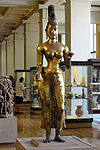 |
54 | Statue of Tara (BM 1830,0612.4 ) | Trincomalee , Sri Lanka | 700-800 | The statue of the Buddhist goddess Tara symbolizes spirituality and sensuality. The statue was excavated in a field where - possibly because of its erotic charisma - it had been hidden for almost 600 years. |
 |
55 | Chinese funerary figures of the Tang Dynasty (BM 1936,1012.227 ) | Luoyang , China | at 728 | 12 figures that were burial objects in the tomb of Liu Tingxun , a general of the Tang Dynasty . During the Tang rule (617–907), China rose to become the richest and most powerful state in the world at that time. |
Part XII - Pilgrims, Robbers and Traders (800-1300)
Episodes 56 to 60 of the radio show began broadcasting June 21, 2010.
| image | No. | object | Place of discovery or production |
time | Brief description |
|---|---|---|---|---|---|
 |
56 | Harrogate deposit found (BM 2009,8023.1 ) | Harrogate , England | 927/928 | This Viking treasure was found in 2007. Over 600 silver objects, mostly coins, were buried in a silver cup the size of a melon. The dating of the coins suggests that the treasure was probably buried by a member of the Norman upper class of the kingdom of Jórvík (later Northumbria ) at the time of the attacks of the English king Königsthelstan on the area. |
 |
57 | Hedwig cup (BM 1959,0414.1 ) | probably Syria / Levant | 1100-1200 | A total of 14 Hedwig beakers preserved in many locations in Europe glass beakers of the same kind. The cups are a miracle legend of Saint Hedwig connected to the effect that the water had turned into wine, drank as Hedwig from her cup. These cups were produced by Muslim artisans, probably in today's Syria, for the European, Christian sales market. They can be understood as symbols for the trade between the Muslim Orient and Europe, which was not interrupted by the Crusades . |
 |
58 | Japanese bronze mirror (BM 1927,1014.2 ) | Bandai Asahi National Park , Japan | 1100-1200 | This bronze mirror was found with hundreds of other mirrors in a pond at the mountain sanctuary of Haguro-san , one of the Three Mountains of Dewa in northern Japan. The mirrors were deposited there as gifts for the gods. The delicate, carefully crafted figurative elements on the back demonstrate the detachment from the more geometric design of such objects in Chinese art. In the Heian period (794–1185), Japan developed politically and culturally completely independently, largely isolated from the continent. |
 |
59 | Buddha head from Borobudur (BM 1859,1228.176 ) | Borobudur , Indonesia | 800-900 | The sculptural style of the head corresponds to the style of Buddha statues from the same period in India and Sri Lanka . Borobudur on the island of Java is one of the largest Buddhist temples in the world, the temple was built between 750 and 850. At this time Hindu and Buddhist temples and monuments were built on Java, both religions came to the island from India on the trade routes that had existed for centuries; the inscription language used in the temple complexes is Indian Sanskrit . |
 |
60 | Pottery shards from Kilwa (BM OA + .916 ) | Kilwa Kisiwani , Tanzania | 900-1400 | Fragments of clay pots, which point to extensive trade connections across the Indian Ocean , centuries before the development of the great European seafaring empires of the Spaniards, Portuguese and English. The pale green porcelain pieces come from China, the dark green and blue pieces belonged to pots that were made in the Persian Gulf , the brown, unglazed pieces come from East Africa. |
Part XIII - Status Symbols (1100–1500)
Episodes 61 to 65 of the radio show started broadcasting June 28, 2010.
| image | No. | object | Place of discovery or production |
time | Brief description |
|---|---|---|---|---|---|
 |
61 | Lewis chess pieces (BM 1831,1101.78 ) | Lewis , Scotland | 1150-1200 | These chess pieces are originally from Norway. The attitudes of the characters reflect the social structure of medieval Nordic society and its myths. The peasants are not shaped figuratively, but represented by game pieces that are reminiscent of the original, more abstract pieces in the Islamic version of the game. |
 |
62 | Hebrew astrolabe (BM 1893,0616.3 ) | Spain | 1300-1400 | An astrolabe is a device for measuring time, determining the calendar date or determining the positions of the stars in the night sky. Astrolabes were precious and difficult to use precision instruments. What is astonishing about this item is that it combines Hebrew inscriptions with Islamic design and recognizable Christian characteristics and thus stands for peaceful cultural contact. |
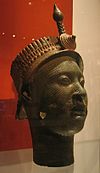 |
63 | Ife head (BM Af1939,34.1 ) | Ile-Ife , Nigeria | 1300-1400 | The Kingdom of the Ife was one of the competing West African empires that emerged during the European Middle Ages . This head - one of a total of 13 identically shaped at the same site - shows an outstanding ability to reproduce human facial features. The precious material and the sophisticated design point to the power and wealth of these African kingdoms. |
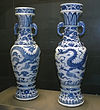 |
64 | David vases (BM PDF, B.613 ) | Jingdezhen , China | 1351 | The David vases were produced when China was part of the Mongol Empire . Trade within the empire made it possible to use cobalt from Iran , that is, from a distant other corner of the territory, to manufacture the precious objects. |
 |
65 | Ritual seat of the Taino (BM Am1949,22.118 ) | Santo Domingo , Dominican Republic | 1292-1399 | The Taíno chiefs of the Caribbean, men and women, used such ritual seats ( duhos , singular duho ) when communicating with the world of their spirits before making important decisions. Only the chiefs themselves or important visitors - such as Christopher Columbus when he arrived in the Caribbean in 1492 - were allowed to sit on it. |
Part XIV - Encounter with the Gods (1200–1500)
Episodes 66 to 70 of the radio show were broadcast from July 5, 2010.
| image | No. | object | Place of discovery or production |
time | Brief description |
|---|---|---|---|---|---|
 |
66 | Dornenreliquiar (BM WB.67 ) | Paris , France | around 1400 | In the biblical Gospels it is recorded that Jesus of Nazareth was put on a crown of thorns at the crucifixion . It became one of the most valuable relics of Christianity in the European Middle Ages . This precious reliquary was made for Jean de Valois to keep a single thorn from the crown. |
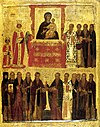 |
67 | Icon of the Triumph of Orthodoxy (BM 1988,0411.1 ) | Istanbul , Turkey | around 1400 | This icon of Orthodox Christianity celebrates a decisive turning point in the history of the Byzantine Empire . In 843 the Empress Theodora II ended the Byzantine Iconoclasm and had the effect that figurative representations of persons related to the biblical story were once again permitted in the service of the Orthodox Church. As the triumph of Orthodoxy , the anniversary of this decision has remained a liturgical holiday of Orthodox Christianity into the 21st century . |
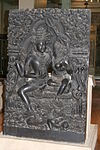 |
68 | Shiva and Parvati sculpture (BM 1872,0701.70 ) | Orissa , India | 1100-1300 | This representation of a pair of gods from Hinduism , the god Shiva and his wife Parvati , represents the close connection between man and woman and marital fidelity. The object was probably placed above the entrance door to a temple. With the help of such sculptures, the believers developed a close relationship with their gods. |
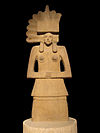 |
69 | Goddess sculpture of the Huaxtecs (BM Am, +. 7001 ) | Mexico | 900-1450 | This statue of a goddess was erected by the Huaxteks , a Central American people who were subjugated by the Aztecs around 1450 . Such goddess statues were scattered all over the Huaxtec territory; the worship of this deity was central to their religiosity. The idea of this goddess later merged with that of the Aztec goddess of sexuality and fertility, Tlazolteotl . |
 |
70 | Hoa-haka-nana-ia (BM Oc1869,1005.1 ) | Orongo (Easter Island) , Chile | 1000-1200 | This Moai statue is from Rapa-nui, Easter Island , one of the most remote inhabited islands in the world. The residents produced about 1,000 such statues, possibly deified former tribal chiefs. Religious veneration ceased around 1600 and no further statues were made. |
Part XV - On the Threshold of the Modern World (1375–1550)
Episodes 71 to 75 of the radio show were broadcast from September 13, 2010.
| image | No. | object | Place of discovery or production |
time | Brief description |
|---|---|---|---|---|---|
 |
71 | The tughra of Suleiman the Magnificent (BM 1949,0409,0.86 ) | Istanbul , Turkey | 1520-1566 | A tughra is the official signature of an Ottoman sultan . During the reign of Suleyman the Magnificent (1520–1566) the Ottoman Empire attained its greatest power and expansion. |
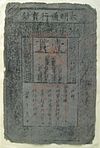 |
72 | Ming banknote (BM CIB, EA.260 ) | China | 1375 | This banknote was issued by the Chinese Emperor Hongwu , the first ruler of the Ming Dynasty . The Ming weren't the first Chinese rulers to introduce banknotes, but they were the first with a comprehensive plan to completely replace all coins with paper money. |
 |
73 | Golden Lama of the Inca (BM Am1921,0721.1 ) | Peru | around 1500 | The small golden statuette was an offering to an Inca mountain god . For the Inca, gold was the sweat of the sun, they believed that the precious metal represented the regenerating power of the sun; the lama was the Inca state's most important economic animal. |
 |
74 | Jade dragon cup (BM 1959,1120.1 ) | Samarkand , Uzbekistan | around 1420-1449 | At the time of production, jade was attributed the property of shattering when it came into contact with poison. The cup was supposed to protect its owner, Ulugh Beg , the ruler of the Timurid Empire , from an attack. |
 |
75 | Dürer's Rhinocerus (BM 1895,0122.714 ) | Germany | 1515 | Albrecht Dürer's anatomically free representation of an Indian rhinoceros shaped the European conception of this animal for the next two centuries. Its template, the exotic animal itself, can be seen as a symbol for European expansion , especially for the colonial history of Portugal ; it was a gift from the Sultan of Cambay to the Portuguese conquerors. |
Part XVI - The First World Economy (1450–1650)
Episodes 76 to 80 of the radio show were broadcast from September 20, 2010.
| image | No. | object | Place of discovery or production |
time | Brief description |
|---|---|---|---|---|---|
 |
76 | Ship automat (BM 1866,1030.1 ) | Augsburg , Germany | 1580-1590 | This mechanical clock by the Augsburg watchmaker and automaton maker Hans Schlottheim , an automatically acting ship model of a galleon , symbolically combines the European trading power of the 16th century with the early modern self-assessment of the Roman-German emperors of the Holy Roman Empire : the central figure is the emperor, surrounded by the seven electors . |
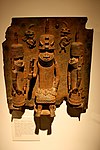 |
77 | Benin tablet: The Oba with Europeans (BM Af1898,0115.23 ) | Benin City , Nigeria | 1500-1700 | In the center of this bronze decorative plate is the Oba , the ruler of the Kingdom of Benin in today's Nigeria, the small figures in the background to the right and left of his head are Portuguese traders. The Kingdom of Benin dominated trade with Europeans from the late 15th to the late 18th centuries. |
 |
78 | Double-headed snake (BM Am1894, -. 634 ) | Mexico | 1400-1521 | The mosaic of the "fire snake" Xiuhcoatl was made in the Aztec Empire ; the piece of jewelry was probably used in religious ceremonies. The Aztec empire was destroyed by the arrival of the Spanish conquerors under Hernando Cortez . |
 |
79 | Kakiemon elephants (BM 1980,0325.1-2 ) | Saga Prefecture , Japan | 1655-1670 | After the fall of the Ming Dynasty in the Chinese Empire in the middle of the 15th century, Japan quickly became the main supplier of porcelain. These so-called Kakiemon style elephants were made for the European market and imported to Europe by the Dutch East India Company . |
 |
80 | Eight reales pieces (BM 1920,0907.382 ) | Potosí , Bolivia | 1556-1598 | The Spanish reales were the first truly global currency; the Spanish silver coins were used throughout the Spanish colonial empire . Most of the silver in the coins came from the Potosí silver mines in Bolivia . Thousands of aborigines and imported African slaves died under the brutal working conditions there. |
Part XVII - Tolerance and Intolerance (1550–1700)
Episodes 81 to 85 of the radio show were broadcast from September 27, 2010.
| image | No. | object | Place of discovery or production |
time | Brief description |
|---|---|---|---|---|---|
 |
81 | Shiite processional standard (BM 1888,0901.16 ) | Iran | 1650-1700 | Similar standards were originally used in Iran as a symbol of the ruler or commander in military battles. They were carried forward in religious processions of the Persian Safavid Empire and can be understood as a symbol of the transition of state and society in Islam from Sunniism to Shiism . |
 |
82 | Miniature of a Mughal prince (BM 1920,0917,0.4 ) | India | around 1610 | The miniature shows an Indian Mughal prince meeting with an elderly Muslim holy man . The picture probably originated during the reign of Jahangir , who frequently visited both Muslim and Hindu clergy. The early Mughal rulers promoted a culture of religious tolerance; Jahangir, like his father Akbar , encouraged the participation of Hindus and Shiites in government and allowed free religious practice. |
 |
83 | Bhima Shaddoll (BM As1859,1228.675 ) | Java , Indonesia | around 1800 | The shadow puppet of Bhima , a hero of the Indian Mahabharata epic, stands for the adaptation of cultural traditions during the advance of Islam in Southeast Asia since the 15th and 16th centuries. Century. In Java, the realistic representation of human or divine beings was considered forbidden by Islam, and the traditional wayang theater became a shadow play. |
 |
84 | Mexican Code Map (BM Am2006, Drg.22070 ) | Mexico | 1550-1600 | The map was produced several decades after the conquest of the Aztec Empire by the Spanish conquistadors (1521). It shows the ownership structure when two branches were founded in the area of Tlaxcala ; the church buildings are highlighted. The map is labeled in an adapted form of the local Tlaxcalteken language with European letters. The Spaniards had justified their conquests in Central and South America with the duty to spread Christianity. |
 |
85 | Flyer for the centenary of the Reformation (BM 1880,0710.299 ) | Leipzig , Germany | 1617 | The large-format leaflet - published shortly before the beginning of the Thirty Years 'War - commemorates the publication of the 95 theses by Martin Luther in 1517, the beginning of the Protestants' opposition to the Roman Catholic Church and the beginning of the Reformation . Leaflets like this played an important role in the propaganda of the confessional age in Central Europe, on the side of the Reformation as well as on that of the Catholic Counter-Reformation . |
Part XVIII - Discovery, Exploitation and Enlightenment (1680-1820)
Episodes 86 to 90 of the radio show were broadcast from October 4, 2010.
| image | No. | object | Place of discovery or production |
time | Brief description |
|---|---|---|---|---|---|
 |
86 | Akan drum (BM Am, SLMisc. 1368 ) |
Ghana , Africa / Virginia , North America |
1700-1800 | This drum was purchased in the then British colony of Virginia at the beginning of the 18th century . However, it originally comes from West Africa, from the Akan region in present-day Ghana , and probably came to Virginia with the Atlantic slave transports . It is one of the oldest surviving items in African American culture. |
 |
87 | Hawaiian feather helmet (BM Oc, HAW.108 ) | Hawaii | 1700-1780 | The feather helmet was a head covering that emphasized the status of a Hawaiian chief. The colors of the bird feathers - red and yellow - are the most important colors of the Hawaiian culture and indicate religious power (" tapu "); Feathers were said to have the ability to strengthen a person's spiritual power (" mana "). The helmet was purchased in 1778 when Europeans first reached Hawaii with James Cook . Hawaii was able to maintain its independence until it was annexed by the USA in 1893. |
 |
88 | North American deer skin map (BM Am2003,19.3 ) | North America | around 1770 | The map shows a large region in the American Midwest between the Mississippi and the Ohio . It was probably made by the Piankashaw Indians on the occasion of negotiations with European immigrants for the sale of settlement areas. |
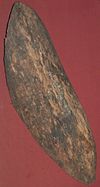 |
89 | Australian bark shield (BM Oc1978, Q.839 ) | New South Wales , Australia | around 1800 | The shield was worn by Aboriginal people who met James Cook at the Botany Bay landing site in 1770 when he first set foot on Australian soil . The aborigines left the shield behind after warning shots by the ship's crew on the run. With Cook's arrival, the European colonization of Australia began, which resulted in the annihilation of much of the original native population. |
 |
90 | Bi-disc made of jade (BM 1937,0416.140 ) | Beijing , China | 1790 | This bi-disk was made around 1200 BC. Manufactured. It bears an inscription of the Chinese Emperor Qianlong from 1790, a ruler of the Qing Dynasty ( Manchu Dynasty ). The disk with this inscription stands for the efforts of the Manchu emperors to reduce the differences between the Manchu and the Han Chinese . |
Part XIX - mass production, mass seduction (1780-1914)
Episodes 91 to 95 of the radio show were broadcast from October 11, 2010.
| image | No. | object | Place of discovery or production |
time | Brief description |
|---|---|---|---|---|---|
 |
91 | Ship chronometer from the HMS Beagle (BM 1958,1006.1957 ) | London , England | 1795-1805 | It was not until the end of the 18th century that British watchmakers succeeded in producing chronometers that allowed a sufficiently precise time measurement from a given starting time, thus solving the problem of length , which had previously impaired seafaring , and making it possible to determine a location with sufficient accuracy on the high seas . This ship chronometer of the HMS Beagle accompanied Charles Darwin on his circumnavigation of the world from 1831 to 1836, the scientific findings of which led him to develop the revolutionary theory of evolution . |
 |
92 | Early Victorian tea service (BM 1909,1201.108 ) | Stoke-on-Trent , England | 1840-1845 | Tea had become a mass product in Great Britain since the beginning of the 19th century, and the same was true for such tea sets. They were made for mass sale, here by the pottery company Josiah Wedgwood & Sons Ltd. , and then if necessary specially decorated, as in this case with silver ornaments, if they should still be luxury items. |
 |
93 | Hokusai's Great Wave (BM 2008,3008.1.JA ) | Edo , Japan | 1831 | Hokusai's Great Wave is one of the world's most famous and artistically influential graphic works. Only after the forced opening of Japan in 1854 did this and other Japanese woodblock prints quickly become known in Europe and celebrated in the art scene. |
 |
94 | Sudanese log drum (BM Af1937,1108.1 ) | Khartoum , Sudan | 1850-1900 | This drum in the shape of a cow probably came to Khartoum from the non-Muslim south of Sudan in the course of enslavement under the rule of the “Mahdi” Muhammad Ahmad . There it fell into the hands of the British Army after the Battle of Omdurman , which marked the end of Mahdi rule in Sudan. The new owners each left their mark on the artifact: there are Islamic decorations and motifs on the sides, and a crown on the back to mark the possession of Queen Victoria . |
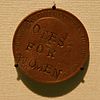 |
95 | Suffragette Penny (BM 1991,0733.1 ) | London, England | 1903 | Overriding the figure of the British King Edward VII. On Penny coins with the inscription Votes for Women ( votes for women ) was one of the propaganda weapons of suffragette movement in Great Britain . Women there only achieved full equality with the right to vote for men in 1928. |
Part XX - The World We Made (1914-2010)
The final episodes 96 to 100 of the radio show were broadcast from October 18, 2010.
| image | No. | object | Place of discovery or production |
time | Brief description |
|---|---|---|---|---|---|
 |
96 | Revolution plate (BM 1990,0506.1 ) | St. Petersburg , Russia | 1921 | The plate shows a worker who steps down the word capital and thus releases new industrial forces. The item celebrates the October Revolution and the formation of the world's first communist state . The plate itself was created in 1901 in the Imperial Porcelain Manufactory in St. Petersburg , but the painting is from 1921: the tsarist luxury objects were intended to symbolize the overcoming of the capitalist system . |
| 97 | Hockneys In the Dull Village (BM 1981,1212.8.8 ) | England | 1966 | The illustration by the British artist David Hockney (* 1937) for a poem by Konstantinos Kavafis (1863–1933) shows two homosexuals naturally and relaxed lying next to each other in bed. Kavafis was one of the first writers to make homosexual love the subject of their work. The drawing was made when the legal and social debate in Great Britain on homosexuality was in full swing: in 1967 its criminality was abolished. | |
 |
98 | Throne of Arms (BM Af2002,01.1 ) | Maputo , Mozambique | 2001 | The sculpture by the Mozambique artist Cristóvão Canhavato ("Kester") is made from unusable weapons from the civil war in Mozambique (1977–1992). The parties to the civil war were supported from abroad by the neighboring (then still) apartheid states of South Africa and Rhodesia on the one hand, and by the (then still) communist Soviet Union on the other; the war resulted in nearly 1 million deaths and 5 million refugees. The war ended when both the apartheid regimes of neighboring states collapsed and the Soviet Union collapsed. The work of art depicts both the tragedy of the war and its overcoming. |
| 99 | Credit card (UAE) (BM 2009,4128.2 ) | Dubai , United Arab Emirates | 2009 | This credit card of HSBC refers partly to the globalization of the modern financial system, on the other hand, the restrictions could hinder the financial transactions in the Islamic states: Islamic law prohibits profit with currency exchange, and this credit card is compatible with the Sharia . In the 20th century, financial transactions were increasingly cashless, initially in western societies. | |
 |
100 | Solar lamp and charging module (BM 2010,2048.1 ) | Shenzhen , China | 2010 | The lamp draws its energy from a small solar module connected to it , which can also be used to charge a mobile phone or smartphone . This object was chosen for the exhibition because it can represent the ingenuity of people - and also the challenges it faces in the 21st century. At the time of the exhibition in 2010, 1.6 billion people on earth had no access to electricity . Objects like this would allow all people regardless of the energy supply to learn and study, to work and to maintain social contacts. |
literature
- Neil MacGregor: A History of the World in 100 Objects , Allen Lane, London 2010, ISBN 978-1-84614-413-4 .
- German: A history of the world in 100 objects . Translated from the English by Waltraut Götting, Andreas Wirthensohn, Annabell Zettel. CH Beck, Munich 2011 (6th edition 2015), ISBN 978-3-406-62147-5 .
Web links
- A History of the World in 100 Objects ( Memento of July 28, 2017 in the Internet Archive ) , website of the British Museum (overview page for the content).
- A History of the World in 100 Objects , BBC website (overview page for content and sound documents).
Remarks
- ↑ Ben Hoyle: British Museum and BBC reveal history of the world in 100 objects , Times / Sunday Times, July 18, 2009. ( Online ( Memento from June 24, 2011 in the Internet Archive ))
- ^ Gillian Reynolds: A History of the World in 100 Objects, Radio 4, review , The Telegraph, January 18, 2010; accessed January 12, 2020.
- ^ British Museum wins Art Fund Prize and is crowned 'Museum of the Year' , press release artfund.org, June 13, 2011; accessed January 12, 2020.
- ^ Mark Brown: British Museum wins Art Fund prize , The Guardian, June 15, 2011; accessed January 12, 2020.
- ^ Bild der Wissenschaft Online: The 6 Knowledge Books of the Year (2012). ( Online ( Memento from January 16, 2013 in the Internet Archive ))
- ↑ data from the British Museum, e.g. in The Olduvai stone chopping tool (inventory number 1934,1214.1) , section Exhibition history ; accessed January 12, 2020.
- ↑ cf. Overview page of the BBC , cf. Overview page of the British Museum ( Memento of July 28, 2017 in the Internet Archive ); accessed January 5, 2020.
- ↑ s. Literature .
- ↑ s. Literature .
- ↑ Date on the BBC data sheet for the first episode ; accessed January 6, 2020.
- ↑ MacGregor 2011, pp. 31-37, BBC ; accessed January 6, 2020.
- ↑ BBC / MacGregor: Transcription of the first radio show Mummy of Hornedjitef , broadcast on January 18, 2010; accessed January 12, 2020.
- ↑ MacGregor 2011, pp. 39-44, BBC ; accessed January 6, 2020.
- ↑ MacGregor 2011, pp. 45-49, BBC ; accessed January 6, 2020.
- ↑ MacGregor 2011, pp. 50-56, BBC ; accessed January 6, 2020.
- ↑ MacGregor 2011, pp. 57-62, BBC ; accessed January 6, 2020.
- ↑ Date of broadcast in the BBC data sheet for the sixth episode ; accessed January 6, 2020.
- ↑ MacGregor 2011, pp. 65-69, BBC ; accessed January 6, 2020.
- ↑ MacGregor 2011, pp. 71-76, BBC ; accessed January 6, 2020.
- ↑ MacGregor 2011, pp. 77-82, BBC ; accessed January 6, 2020.
- ↑ MacGregor 2011, pp. 83-88, BBC ; accessed January 6, 2020.
- ↑ MacGregor 2011, pp. 89-94, BBC ; accessed January 6, 2020.
- ↑ Date of broadcast in the BBC data sheet for the eleventh episode ; accessed January 6, 2020.
- ↑ MacGregor 2011, pp. 97-102, BBC ; accessed January 6, 2020.
- ↑ MacGregor 2011, pp. 103-113, BBC ; accessed January 6, 2020.
- ↑ MacGregor 2011, pp. 115-119, BBC ; accessed January 6, 2020.
- ↑ MacGregor 2011, pp. 121-125, BBC ; accessed January 6, 2020.
- ↑ MacGregor 2011, pp. 127-131, BBC ; accessed January 6, 2020.
- ↑ Date of broadcast in the BBC data sheet for the 16th episode ; accessed January 6, 2020.
- ↑ MacGregor 2011, pp. 135-140, BBC ; accessed January 6, 2020.
- ↑ MacGregor 2011, pp. 141-149, BBC ; accessed January 6, 2020.
- ↑ MacGregor 2011, pp. 151-156, BBC ; accessed January 6, 2020.
- ↑ MacGregor 2011, pp. 157-164, BBC ; accessed January 6, 2020.
- ↑ MacGregor 2011, p. 168.
- ↑ MacGregor 2011, pp. 165-170, BBC ; accessed January 6, 2020.
- ↑ Date of broadcast in the BBC data sheet for the 21st episode ; accessed January 6, 2020.
- ↑ MacGregor 2011, pp. 173-179, BBC ; accessed January 6, 2020.
- ↑ MacGregor 2011, pp. 181-185, BBC ; accessed January 6, 2020.
- ↑ MacGregor 2011, pp. 187-192, BBC ; accessed January 6, 2020.
- ↑ MacGregor 2011, pp. 193-198, BBC ; accessed January 6, 2020.
- ↑ MacGregor 2011, pp. 199-204, BBC ; accessed January 6, 2020.
- ↑ Date of broadcast in the BBC data sheet for the 26th episode ; accessed January 6, 2020.
- ↑ MacGregor 2011, pp. 207-213, BBC ; accessed January 6, 2020.
- ↑ MacGregor 2011, pp. 215-220, BBC ; accessed January 6, 2020.
- ↑ MacGregor 2011, pp. 221-227, BBC ; accessed January 6, 2020.
- ↑ MacGregor 2011, pp. 229-235, BBC ; accessed January 6, 2020.
- ↑ MacGregor 2011, pp. 237-241, BBC ; accessed January 6, 2020.
- ↑ Date of broadcast of the BBC data sheet for the 31st episode ; accessed January 6, 2020.
- ↑ MacGregor 2011, pp. 245-251, BBC ; accessed January 6, 2020.
- ↑ MacGregor 2011, pp. 253-257, BBC ; accessed January 6, 2020.
- ↑ MacGregor 2011, pp. 259-264, BBC ; accessed January 6, 2020.
- ↑ MacGregor 2011, pp. 265-270, BBC ; accessed January 6, 2020.
- ↑ MacGregor 2011, pp. 271-277, BBC ; accessed January 6, 2020.
- ↑ Date of broadcast in the BBC data sheet for the 36th episode ; accessed January 6, 2020.
- ↑ MacGregor 2011, pp. 281-287, BBC ; accessed January 6, 2020.
- ↑ MacGregor 2011, pp. 289-293, BBC ; accessed January 6, 2020.
- ↑ MacGregor 2011, pp. 295-300, BBC ; accessed January 6, 2020.
- ↑ MacGregor 2011, pp. 301-309, BBC ; accessed January 6, 2020.
- ↑ MacGregor 2011, pp. 311-315, BBC ; accessed January 6, 2020.
- ↑ Date of broadcast in the BBC data sheet for the 41st episode ; accessed January 6, 2020.
- ↑ MacGregor 2011, pp. 319-323, BBC ; accessed January 6, 2020.
- ↑ MacGregor 2011, pp. 325-331, BBC ; accessed January 6, 2020.
- ↑ MacGregor 2011, pp. 333-336, BBC ; accessed January 6, 2020.
- ↑ MacGregor 2011, pp. 339-344, BBC ; accessed January 6, 2020.
- ↑ MacGregor 2011, pp. 345-351, BBC ; accessed January 6, 2020.
- ↑ Date of broadcast in the BBC data sheet for the 46th episode ; accessed January 6, 2020.
- ↑ MacGregor 2011, pp. 355-361, BBC ; accessed January 6, 2020.
- ↑ MacGregor 2011, pp. 363-368, BBC ; accessed January 6, 2020.
- ↑ MacGregor 2011, pp. 369-375, BBC ; accessed January 6, 2020.
- ↑ MacGregor 2011, pp. 377-381, BBC ; accessed January 6, 2020.
- ↑ MacGregor 2011, pp. 383-389, BBC ; accessed January 6, 2020.
- ↑ Date of broadcast in the BBC data sheet for the 51st episode ; accessed January 6, 2020.
- ↑ MacGregor 2011, pp. 393-398, BBC ; accessed January 6, 2020.
- ↑ MacGregor 2011, pp. 399-405, BBC ; accessed January 6, 2020.
- ↑ MacGregor 2011, pp. 407-412, BBC ; accessed January 6, 2020.
- ↑ MacGregor 2011, pp. 413-418, BBC ; accessed January 6, 2020.
- ↑ MacGregor 2011, pp. 419-426, BBC ; accessed January 6, 2020.
- ↑ Date of broadcast in the BBC data sheet for the 56th episode ; accessed January 6, 2020.
- ↑ MacGregor 2011, pp. 429-434, BBC ; accessed January 6, 2020.
- ↑ MacGregor 2011, pp. 435-440, BBC ; accessed January 6, 2020.
- ↑ MacGregor 2011, pp. 441-446, BBC ; accessed January 6, 2020.
- ↑ MacGregor 2011, pp. 447-453, BBC ; accessed January 6, 2020.
- ↑ MacGregor 2011, pp. 455-459, BBC ; accessed January 6, 2020.
- ↑ Date of broadcast in the BBC data sheet for the 61st episode ; accessed January 6, 2020.
- ↑ MacGregor 2011, pp. 463-467, BBC ; accessed January 6, 2020.
- ↑ MacGregor 2011, pp. 469-473, BBC ; accessed January 6, 2020.
- ↑ MacGregor 2011, pp. 475-479, BBC ; accessed January 6, 2020.
- ↑ MacGregor 2011, pp. 481-485, BBC ; accessed January 6, 2020.
- ↑ MacGregor 2011, pp. 487-492, BBC ; accessed January 6, 2020.
- ↑ Date of broadcast in the BBC data sheet for the 66th episode ; accessed January 6, 2020.
- ↑ MacGregor 2011, pp. 495-500, BBC ; accessed January 6, 2020.
- ↑ MacGregor 2011, pp. 501-506, BBC ; accessed January 6, 2020.
- ↑ MacGregor 2011, pp. 507-512, BBC ; accessed January 6, 2020.
- ↑ MacGregor 2011, pp. 513-518, BBC ; accessed January 6, 2020.
- ↑ MacGregor 2011, pp. 519-526, BBC ; accessed January 6, 2020.
- ↑ Date of broadcast in the BBC data sheet for the 71st episode ; accessed January 6, 2020.
- ↑ MacGregor 2011, pp. 528-534, BBC ; accessed January 6, 2020.
- ↑ MacGregor 2011, pp. 535-541, BBC ; accessed January 6, 2020.
- ↑ MacGregor 2011, pp. 543-548, BBC ; accessed January 6, 2020.
- ↑ MacGregor 2011, pp. 549-556, BBC ; accessed January 6, 2020.
- ↑ MacGregor 2011, pp. 557-563, BBC ; accessed January 6, 2020.
- ↑ Date of broadcast in the BBC data sheet for the 76th episode ; accessed January 6, 2020.
- ↑ MacGregor 2011, pp. 567-572, BBC ; accessed January 6, 2020.
- ↑ MacGregor 2011, pp. 573-578, BBC ; accessed January 6, 2020.
- ↑ MacGregor 2011, pp. 580-587, BBC ; accessed January 6, 2020.
- ↑ MacGregor 2011, pp. 589-593, BBC ; accessed January 6, 2020.
- ↑ MacGregor 2011, pp. 595-600, BBC ; accessed January 6, 2020.
- ↑ Date of broadcast in the BBC data sheet for the 81st episode ; accessed January 6, 2020.
- ↑ MacGregor 2011, pp. 603-610, BBC ; accessed January 6, 2020.
- ↑ MacGregor 2011, pp. 611-616, BBC ; accessed January 6, 2020.
- ↑ MacGregor 2011, pp. 617-624, BBC ; accessed January 6, 2020.
- ↑ MacGregor 2011, pp. 625-632, BBC ; accessed January 6, 2020.
- ↑ MacGregor 2011, pp. 633-639, BBC ; accessed January 6, 2020.
- ↑ Date of broadcast in the BBC data sheet for the 86th episode ; accessed January 6, 2020.
- ↑ MacGregor 2011, pp. 643-647, BBC ; accessed January 6, 2020.
- ↑ MacGregor 2011, pp. 649-654, BBC ; accessed January 6, 2020.
- ↑ MacGregor 2011, pp. 655-663, BBC ; accessed January 6, 2020.
- ↑ MacGregor 2011, pp. 665-670, BBC ; accessed January 6, 2020.
- ↑ MacGregor 2011, pp. 671-678, BBC ; accessed January 6, 2020.
- ↑ Date of broadcast in the BBC data sheet for the 91st episode ; accessed January 6, 2020.
- ↑ MacGregor 2011, pp. 681-685, BBC ; accessed January 6, 2020.
- ↑ MacGregor 2011, pp. 687-692, BBC ; accessed January 6, 2020.
- ↑ MacGregor 2011, pp. 693-700, BBC ; accessed January 6, 2020.
- ↑ MacGregor 2011, pp. 701-708, BBC ; accessed January 6, 2020.
- ↑ MacGregor 2011, pp. 709-715, BBC ; accessed January 6, 2020.
- ↑ Date of broadcast in the BBC data sheet for the 96th episode ; accessed January 6, 2020.
- ↑ MacGregor 2011, pp. 719-724, BBC ; accessed January 6, 2020.
- ↑ MacGregor 2011, pp. 725-731, BBC ; accessed January 6, 2020.
- ↑ MacGregor 2011, pp. 733-738, BBC ; accessed January 6, 2020.
- ↑ MacGregor 2011, pp. 739-745, BBC ; accessed January 6, 2020.
- ↑ MacGregor 2011, pp. 747-753, BBC ; accessed January 6, 2020.